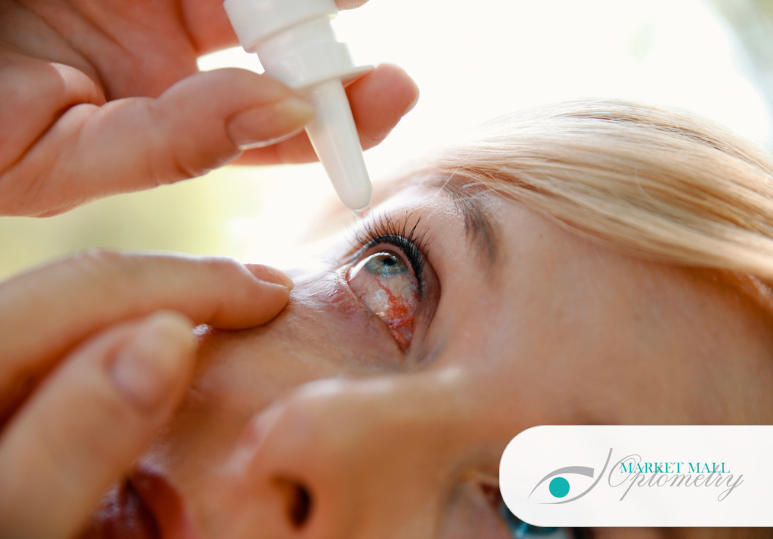Types Of Eye Discharge
Yellow
This type of mucusy discharge is often accompanied by a stye or nodule on the eyelid, both of these appearing as bumps of various sizes. Your eyelid will likely feel tender, especially when you blink. If the stye or nodule becomes infected, it may develop pus and resemble a pimple. Do not squeeze the bump, as this can result in a worse infection. Instead, visit an optometrist.
Green Or Grey
This type of discharge is common when there is an eye infection such as conjunctivitis (commonly known as pink eye). If you’ve ever had pink eye you are likely familiar with the feeling that your eyes are glued shut when you first wake up. This is because the discharge dries out during the night and leaves the eyes feeling like they have a layer of crust on them. This discharge will likely be accompanied by other signs of bacterial conjunctivitis, such as a red or pink hue to the eyelids and the whites of the eyes, as well as eye irritation.
White And Stringy
This can also be related to a form of conjunctivitis but one that is typically caused by allergies. Your allergy-induced pink eye may produce mucus that accumulates under the lower eyelid. This is sometimes treated using artificial tears to help dilute antigens in the tears, while other times it is treated using prescription eye drops or oral medication.
Crusted
If your eyes or eyelashes have developed a crust, it may be due to blepharitis, which is an inflammation of the eyelids when oil glands become blocked or bacteria grows on the eyelids and eyelashes. This condition can also cause dry, flaky, scaly skin on the eyelids. Despite any itchiness, irritation, or desire to scratch the dead skin off, try not to rub the eyes as it can cause further irritation and may worsen infection as bacteria transfer from the fingers to the eyes. One way to reduce these symptoms is to gently wash the eyelids with a baby shampoo that will cleanse the eyes without causing stinging.
Yellow Or White Balls Of Mucus
This infection in the nasolacrimal sac is called dacryocystitis and it is often accompanied by a blockage in the nasolacrimal duct. When a person has dacryocystitis, they will likely have a bump just below the inner corner of the eye and this bump will be filled with yellow or white mucus and will be swollen, red, and tender. If the mucus discharges, it will be through the drainage holes near the inner corner of the eyelids called the puncta. Dacryocystitis should be treated with antibiotics or with surgery if it is severe.
Dry Pieces Of Mucus
If you have Dry Eye Syndrome, you will likely wake up with small particles of dried mucus in the corners of the eye. This is a clumping of oils and mucus due to a lack of adequate tears. The symptoms of dry eyes can be addressed using artificial tears, warm compresses, or using a humidifier in your home or bedroom. For more severe dry eye symptoms, visit your optometrist to discuss steroid eye drops or punctal plugs.
Visit A Calgary Optometrist If You Have Eye Discharge
If you or your child experience any abnormal eye discharge, book an eye exam with a Calgary optometrist. Discharge can be a sign that the eye is infected and needs medical treatment, such as prescription eye drops or oral medication. At Market Mall Optometry, our professional Calgary optometrists will administer an eye exam to determine the cause of the discharge and will also examine your overall eye health to ensure your ocular wellness. Market Mall Optometry offers adult eye exams, as well as children’s eye exams and eye exams for seniors, so we can help everyone who may be suffering from an eye infection. To book an eye exam for any age, contact Market Mall Optometry in Calgary either at 1-403-286-4884 or through the online contact form.
FAQ
Q: What does an eye exam at Market Mall Optometry in Calgary typically include?
A: Your Calgary eye doctor will:
- Assess colour deficiency
- Measure depth perception
- Measure the pressure inside of your eyes
- Measure your existing glasses prescription
- Review any health concerns you may have or that may be in your family history
- Examine your eyes with and without the help of lenses
- Fully assess the health of your eyes
- Take retinal photos to assess the health of the back of your eyes
- Give an optometrist-determined prescription if needed
Q: Are comprehensive eye exams uncomfortable?
A: A comprehensive eye exam is non-invasive so you will not feel any pain or discomfort for the duration of the exam.
Q: How often should adults visit their optometrist?
A: According to the Canadian Association Of Optometrists, children should get an eye exam once a year until they turn 18, while adults are recommended to visit their optometrist to receive a comprehensive eye exam once every two years. Adults over the age of 65 should visit their optometrist annually. You should also schedule an eye exam if any eye complications arise, such as the sudden production of discharge, changes to vision, eye irritation, or other new symptoms or conditions.





